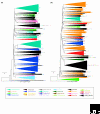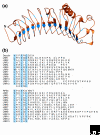Plant NBS-LRR proteins: adaptable guards
- PMID: 16677430
- PMCID: PMC1557992
- DOI: 10.1186/gb-2006-7-4-212
Plant NBS-LRR proteins: adaptable guards
Abstract
The majority of disease resistance genes in plants encode nucleotide-binding site leucine-rich repeat (NBS-LRR) proteins. This large family is encoded by hundreds of diverse genes per genome and can be subdivided into the functionally distinct TIR-domain-containing (TNL) and CC-domain-containing (CNL) subfamilies. Their precise role in recognition is unknown; however, they are thought to monitor the status of plant proteins that are targeted by pathogen effectors.
Figures





References
-
- Jones DA, Jones JDG. The role of leucine-rich repeat proteins in plant defenses. Adv Bot Res. 1997;24:90–167.
Publication types
MeSH terms
Substances
LinkOut - more resources
Full Text Sources
Other Literature Sources
Research Materials
Miscellaneous

